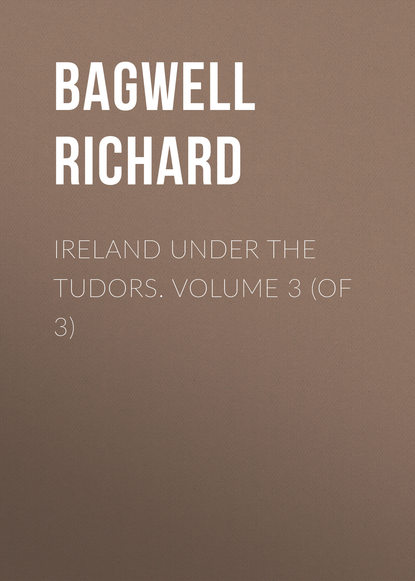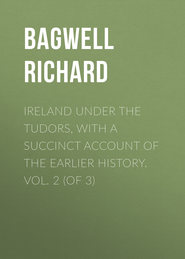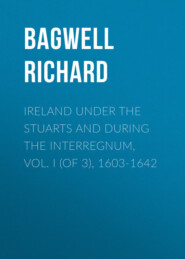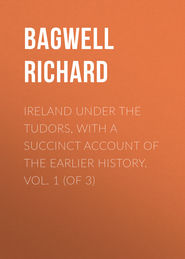По всем вопросам обращайтесь на: info@litportal.ru
(©) 2003-2024.
✖
Ireland under the Tudors. Volume 3 (of 3)
Настройки чтения
Размер шрифта
Высота строк
Поля
310
Report on state of Ireland April 1599, in Carew, and further particulars in Dymmok’s Treatise of Ireland (ed. Butler, Irish Arch. Society, 1843). Dymmok’s account of the Leinster and Munster journey is, with slight omissions, word for word (but better spelt) Harrington’s journal from May 10 to July 3, after which it is continued from other sources. (Nugæ Antiquæ, i. 268-292.) There is an independent journal in Carew from May 21 to July 1. The opinion of the Irish Council is printed by Devereux, i. 24. Essex to the Privy Council, April 29. Sir H. Wotton to Ed. Reynolds, April 19, MS. Hatfield, where it is noted that Sir H. Wallop died within an hour of the Lord Lieutenant’s arrival.
311
Nugæ Antiquæ, i. 269-275; Four Masters; O’Sullivan Bere, tom. iii. lib. v. cap. 9. O’Donovan cannot exactly identify the ‘transitus plumarum,’ and the name is forgotten in the district. Harrington places it between Croshy Duff hill, which is two and a half miles from Maryborough on the Timahoe road, and Cashel, which is four miles from Maryborough on the Ballyroan road. Captain Lee, in Desiderata Curiosa Hibernica, i. 114, suggests that Tyrone would willingly settle all his differences with Bagenal (whom he very wrongly accuses of cowardice) by a duel. Tyrone was the last man in the world to do such an act of folly, but Lee exposes his own character.
312
The Lord President, Ormonde, and other councillors ‘hath persuaded me for a few days to look into his government.’ – Essex to the Privy Council, May 21, 1599, MS. Hatfield. The few days were a full month. Nugæ Antiquæ, i. 275-278; Journal of occurrents in Carew, under June 22. The battery was planted on May 28, and all was over by the 31st. ‘The castle of Cahir, very considerable, built upon a rock, and seated in an island in the midst of the Suir, was lately rendered to me. It cost the Earl of Essex, as I am informed, about eight weeks’ siege with his army and artillery. It is now yours without the loss of one man.’ – Cromwell to Bradshaw, March 5, 1649. Thus history is falsified by flattery and local vanity. There is a picture-plan of the siege in Pacata Hibernia.
313
Journal of occurrents in Carew, under June 22; Nugæ Antiquæ, i. 278-280. The Journal, the Four Masters, and O’Sullivan Bere, tom. iii. lib. v. cap. 6, all agree that Norris died of a wound in the head. ‘Kilthilia’ may be Kilteely near Hospital, whither the Journal says the wounded man was first carried. He died in his own house at Mallow.
314
Nugæ Antiquæ and Journal ut sup. Essex left Askeaton on the 8th, and arrived at Waterford on June 21. The Queen to Lord and Lady Norris, Sept. 6, in S.P. Domestic, and Rowland Whyte to Sir R. Sidney, Sept. 8, in Sidney Papers.
315
The contemporary accounts are collected in National MSS. of Ireland, part iv. i. app. xiv. Atherton’s is the most minute. There is also a field-sketch made by Captain Montague. The Irish were not numerically stronger than Harrington’s force. Loftus, who died at Wicklow for want of a skilful surgeon, was the archbishop’s son.
316
Journal in Carew, under July 1; Nugæ Antiquæ, i. 254, 259, and 286-292; Dymmok’s Treatise. Essex left Waterford June 22, and reached Dublin July 2.
317
Essex to the Privy Council, July 11; Devereux, ii. 50-52; Fynes Moryson, part ii. lib. i. cap. i.; Nugæ Antiquæ, i. 292; Reliquiæ Wottonianæ.
318
Privy Council to Essex, June 10; Essex to the Privy Council, July 11; the Queen to Essex, July 19.
319
Essex to the Privy Council, May 21, MS. Hatfield; Cecil to Sir H. Neville, May 23, in Winwood’s Memorials; Chamberlain’s Letters, June 10; Essex to the Queen, June 25, in Moryson; the Queen to Essex, July 19.
320
Dymmok’s Treatise, p. 43; Nugæ Antiquæ, i. 255; the Queen to Essex, July 19 and Aug. 10. Harrington’s comrade was Gerald, fourteenth Earl of Kildare. The ‘sergeant-major’ was either Captain Richard Cuny or Captain George Flower.
321
The Queen to the Lord Lieutenant and Council, Aug. 10 in Carew; Chamberlain’s Letters, Aug. 23.
322
Dymmok’s Treatise, p. 44; Nugæ Antiquæ, i. 255-257 and 264-268; Four Masters. Harrington was present, and Dymmok’s account is from those who were. O’Sullivan Bere says the English lost 1,400 men, but Harrington says Clifford’s whole force hardly amounted to that number. O’Donnell, though not far off, took no actual part in the fight. H. Cuffe to E. Reynolds, Aug. 11, MS. Hatfield, written when the bad news was quite fresh.
323
Four Masters; MacDermot’s letter is in Dymmok; Essex’s instructions for Dillon, Savage, and Dunkellin in Carew, Aug. 10. Dymmok gives Aug. 15 as the date of Clifford’s death, but it must have been a week earlier.
324
Essex to the Queen, soon after Aug. 15, in Devereux, ii. 56, and two other letters at p. 67. The officers’ declaration is at p. 55, where the names of the signatories are given. They fairly justify the Queen’s stricture in her letter of Sept. 14.
325
Dymmok’s Treatise; Journal in Carew, No. 315. The two accounts substantially agree. It was the hereditary privilege of O’Hagan to inaugurate O’Neill.
326
Journal in Carew and Dymmok ut sup. Moryson and Camden closely agree. The chronology is as follows: Essex leaves Dublin Aug. 28; musters at Castle Kieran, Aug. 31; between Robinstown and Newcastle, Sept. 2; Ardee, Sept. 3; Mills of Louth, Sept. 4; O’Hagan’s first overtures, Sept. 5; the meeting at Bellaclinthe, Sept. 7; cessation concluded, Sept. 8; Essex goes to Drogheda, Sept. 9. See also Shirley’s Monaghan, p. 104. There is a story told somewhere that Tyrone spoke much of religion, and that Essex answered, ‘Go to, thou carest as much for religion as my horse.’ The original articles of cessation, dated Sept. 8 and signed Hugh Tyrone, are at Hatfield.
327
Essex to the Queen, Aug. 30, from Ardbraccan; the Queen to Essex. Sept. 14 and 17 – all printed by Devereux. On March 27, Essex had licence at his own request ‘to return to her Majesty’s presence at such times as he shall find cause,’ but this was revoked by her letter of July 30. Sir H. Wotton to E. Reynolds, April 19, MS. Hatfield.
328
Harrington to Justice Carey in Nugæ Antiquæ, i. 247. Park gives April as the date of this letter, but this is disproved by internal evidence, and it certainly belongs to October. See also ib. pp. 260 and 340. Warren’s own account of his ‘second journey to the Earl of Tyrone,’ is dated Oct. 20. The first lines of the 45th canto of Harrington’s translation of Orlando are: —
Look how much higher Fortune doth erect
The climbing wight on her unstable wheel,
So much the higher may a man expect
To see his head where late he saw his heel, &c.
329
Sir Christopher St. Lawrence, according to Camden, offered his services to kill both the peer and the secretary.
330
Letters from Rowland Whyte to Sir Robert Sidney in Sidney Papers, ii. 117, 127, from Sept. 19 to Oct. 2; Essex’s Relation, written by him during his imprisonment.
331
The letter to Essex is of Nov. 22, and with seventeen others belonging to the last three months of 1599, is printed by Mr. Gilbert in App. 16 to National Manuscripts, Ireland, part iv. 1. In a letter of Nov. 6, to the Lords Justices, Lord Lieutenant (Ormonde), and Council, the Queen approves of the slaughter by Ormonde ‘in revenge of that that brake the cessation in Wexford… do not irritate nor oppress any such as have submitted … in respect of any private unkindness of your own.’
332
‘Tyrone’s Propositions, 1599’ are in Winwood’s Memorials, i. 118, immediately after Cecil’s letter of Oct. 8 to Neville, and are reprinted by Spedding and Abbott. The letter does not mention any enclosure. In Bacon and Essex, pp. 134-148, Dr. Abbott endeavours, not very successfully, I think, to show that the document is entirely unworthy of credit. It is, however, not called ‘Essex’s propositions,’ but ‘Tyrone’s,’ and I have shown that the most outrageous part of it was regarded by the Queen as a serious proposal. Essex should have broken off the conference at the mere mention of such a thing. Sidney would have done so, or Norris, or Mountjoy. The Queen’s letters to Fenton and to the Lords Justices, &c., are of Nov. 5 and 6.
333








